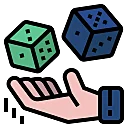Quants Menu
- HCF and LCM
- Number System
- Number Decimals & Fractions
- Surds and Indices
- Divisibility
- Ages
- LCM
- HCF
- Inverse
- Speed Time and Distance
- Work and Time
- Boats and Streams
- Pipes and Cisterns
- Averages
- Allegations and Mixtures
- Ratio and Proportions
- Simple & Compound Interest
- Simple Interest
- Compound Interest
- Percentages
- Profit & Loss
- Successive Discount 1
- Successive Discount 2
- AP GP HP
- Arithmetic Progressions
- Geometric Progressions
- Harmonic Progressions
- Probability
- Permutation & Combination
- Combination
- Circular Permutation
- Geometry
- Heights and Distances
- Perimeter Area and Volume
- Coordinate Geometry
- Venn Diagrams
- Set Theory
- Algebra
- Linear Equations
- Quadratic Equations
- Logarithms
- Clocks
- Calendars
- Clocks and Calendars
- Finding remainder of large powers
PREPINSTA PRIME
Tips And Tricks And Shortcuts For Probability Questions
Tips and Tricks and Shortcuts for Probability
The Event which is likely to occur, measured by the ratio of the Favourable cases to the whole number of cases possible , known as Probability. In this Page Tips and Tricks for Probability is given.

Tips for Probability
Probability is a measure of the likelihood of an event occurring, which is determined by the ratio of favorable outcomes to the total number of possible outcomes.
The formula for calculating probability is:
P(E) = \frac{Number of Favorable Outcomes}{Total Number of Possible Outcomes}
- In mathematical terms,
Probability represents the ratio of desired outcomes to the total number of possible outcomes. - When solving probability questions, if it is easier to find the probability of an event not happening, you can calculate that probability and subtract it from 1.
- When encountering the term “or” in a question,
Use addition (+) when applying the Fundamental Principle of Counting to solve the problem. - When encountering the term “and” in a question,
Use multiplication (x) when applying the Fundamental Principle of Counting to solve the problem.
Tips and Tricks for Probability Questions and their solution
Question 1. A die is rolled, find the probability that an even number is obtained ?
Options
(a) \frac{3}{4}
(b) \frac{1}{2}
(c) \frac{1}{4}
(d) None of these
Solutions Let us first write the sample space, S of the experiment.
S={1,2,3,4,5,6}
Let E be the event “an even number is obtained” and write down.
E= {2,4,6}
We can use the formula of the classical probability.
P(E)= \frac{n(E)}{n(S)} = \frac{3}{6} = \frac{1}{2}.
Correct Options (b)
Prime Course Trailer
Related Banners
Get PrepInsta Prime & get Access to all 200+ courses offered by PrepInsta in One Subscription
Question 2. Two coins are tossed, find the probability that two heads are obtained. Note: Each coin has two possible outcomes H (heads) and T (Tails).
Options
(a) \frac{1}{4}
(b) \frac{1}{2}
(c) \frac{3}{2}
(d) None of these
Solutions The sample space S is given by.
S = {(H,T),(H,H),(T,H),(T,T)}
Let E be the event “two heads are obtained”.
E = {(H,H)}
We use the formula of the classical probability.
P(E) = \frac{n(E)}{n(S)} = \frac{1}{4}
Correct Options (a)
Question 3. Two dice are rolled, find the probability that the sum is
a) equal to 1
b) equal to 4
c) less than 13
Solution The sample space S of two dice is shown below.
S = {(1,1),(1,2),(1,3),(1,4),(1,5),(1,6)
(2,1),(2,2),(2,3),(2,4),(2,5),(2,6)
(3,1),(3,2),(3,3),(3,4),(3,5),(3,6)
(4,1),(4,2),(4,3),(4,4),(4,5),(4,6)
(5,1),(5,2),(5,3),(5,4),(5,5),(5,6)
(6,1),(6,2),(6,3),(6,4),(6,5),(6,6)}
a) Let E be the event “sum equal to 1”. There are no outcomes which correspond to a sum equal to 1, hence
P(E) = \frac{n(E)}{n(S)} = \frac{0}{36} = 0
Quickest Way : Sum is always greater than or equal to 1 . So it is Impossible Event means Probability will be 0.
b) Three possible outcomes give a sum equal to 4: E = {(1,3),(2,2),(3,1)}, hence.
P(E) = \frac{n(E)}{n(S)} = \frac{3}{36} = \frac{1}{12}
c) All possible outcomes, E = S, give a sum less than 13, hence.
P(E) = \frac{n(E)}{n(S)} = \frac{36}{36} = 1
Quickest Way : Sum is always less than 13 . So it is sure Event means Probability will be 1.
Question 4. A Speak truth truth in 20 % of cases and B in 40 % of cases. In what Percentages of cases are they likely to Contradict to each other in
Narrating the Same Event?
Options
(a) 40 %
(b) 44 %
(c) 42 %
(d) None of these
Solutions They contradict each other if one of them Speaks and the other one lies. and vice – versa.
Required Percentages = 0.20 x (1 – 0.40 ) + (1- 0.20) x 0.40 = 0.44 = 44 %
Correct Option (b)
Also Check Out
Get over 200+ course One Subscription
Courses like AI/ML, Cloud Computing, Ethical Hacking, C, C++, Java, Python, DSA (All Languages), Competitive Coding (All Languages), TCS, Infosys, Wipro, Amazon, DBMS, SQL and others
- Permutation & Combination – Questions | Formulas | How to Solve Quickly | Tricks & Shortcuts
Others
- Combination – Questions | Formulas | How to Solve Quickly | Tricks & Shortcuts
- Circular Permutation – Questions | Formulas | How to Solve Quickly | Tricks & Shortcuts
- Permutation & Combination –
Questions |
Formulas |
How to Solve Quickly |
Tricks & Shortcuts
Others
- Combination –
Questions |
Formulas |
How to Solve Quickly |
Tricks & Shortcuts - Circular Permutation –
Questions |
Formulas |
How to Solve Quickly |
Tricks & Shortcuts

 Apply For Jobs
Apply For Jobs Get Hiring Updates
Get Hiring Updates




Thanks for your tips and tricks
It’s very useful for me to solve probability related sums